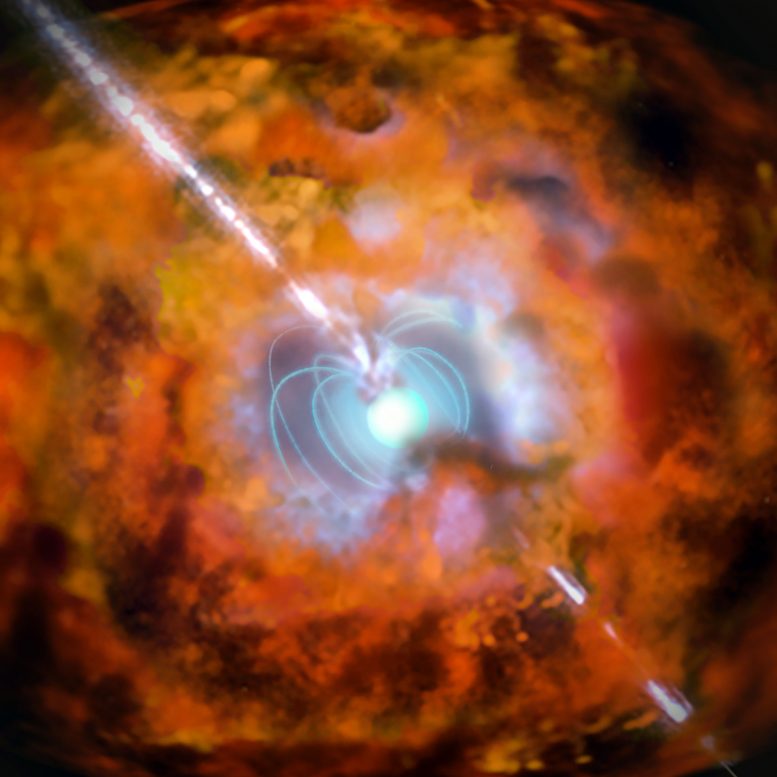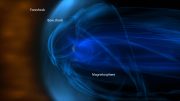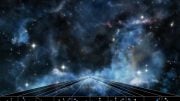
This artist’s impression shows a supernova and associated gamma-ray burst driven by a rapidly spinning neutron star with a very strong magnetic field — an exotic object known as a magnetar. Credit: ESO
ESO’s La Silla and Paranal Observatories have demonstrated for the first time a link between a very long-lasting burst of gamma rays and an unusually bright supernova explosion. The study reveals that the supernova following the burst GRB 111209A was not driven by radioactive decay, as expected, but was instead powered by the decaying super-strong magnetic fields around a magnetar.
The results appear in the journal Nature.
Gamma-ray bursts (GRBs) are one of the outcomes associated with the biggest explosions to have taken place since the Big Bang. They are detected by orbiting telescopes that are sensitive to this type of high-energy radiation, which cannot penetrate the Earth’s atmosphere, and then observed at longer wavelengths by other telescopes both in space and on the ground.
GRBs usually only last a few seconds, but in very rare cases the gamma rays continue for hours. One such ultra-long duration GRB was picked up by the Swift satellite on 9 December 2011 and named GRB 111209A. It was one of the longest and brightest GRBs ever observed.
As the afterglow from this burst faded it was studied using both the GROND instrument on the MPG/ESO 2.2-meter (7.2-foot) telescope at La Silla and also with the X-shooter instrument on the Very Large Telescope (VLT) at Paranal. The clear signature of a supernova, later named SN 2011kl, was found. This is the first time that a supernova has been found to be associated with an ultra-long GRB.
The lead author of the new paper, Jochen Greiner from the Max-Planck-Institut für extraterrestrische Physik, Garching, Germany explains: “Since a long-duration gamma-ray burst is produced only once every 10,000–100,000 supernovae, the star that exploded must be somehow special. Astronomers had assumed that these GRBs came from very massive stars — about 50 times the mass of the Sun — and that they signaled the formation of a black hole. But now our new observations of the supernova SN 2011kl, found after the GRB 111209A, are changing this paradigm for ultra-long duration GRBs.”
In the favored scenario of a massive star collapse (sometimes known as a collapsar), the week-long burst of optical/infrared emission from the supernova is expected to come from the decay of radioactive nickel-56 formed in the explosion. But in the case of GRB 111209A the combined GROND and VLT observations showed unambiguously for the first time that this could not be the case. Other suggestions were also ruled out.
The only explanation that fitted the observations of the supernova following GRB 111209A was that it was being powered by a magnetar — a tiny neutron star spinning hundreds of times per second and possessing a magnetic field much stronger than normal neutron stars, which are also known as radio pulsars. Magnetars are thought to be the most strongly magnetized objects in the known Universe. This is the first time that such an unambiguous connection between a supernova and a magnetar has been possible.
Paolo Mazzali, co-author of the study, reflects on the significance of the new findings: “The new results provide good evidence for an unexpected relation between GRBs, very bright supernovae, and magnetars. Some of these connections were already suspected on theoretical grounds for some years, but linking everything together is an exciting new development.”
“The case of SN 2011kl/GRB 111209A forces us to consider an alternative to the collapsar scenario. This finding brings us much closer to a new and clearer picture of the workings of GRBs,” concludes Jochen Greiner.
Reference: “A very luminous magnetar-powered supernova associated with an ultra-long gamma-ray burst” by Jochen Greiner, Paolo A. Mazzali, D. Alexander Kann, Thomas Krühler, Elena Pian, Simon Prentice, Felipe Olivares E., Andrea Rossi, Sylvio Klose, Stefan Taubenberger, Fabian Knust, Paulo M. J. Afonso, Chris Ashall, Jan Bolmer, Corentin Delvaux, Roland Diehl, Jonathan Elliott, Robert Filgas, Johan P. U. Fynbo, John F. Graham, Ana Nicuesa Guelbenzu, Shiho Kobayashi, Giorgos Leloudas, Sandra Savaglio, Patricia Schady, Sebastian Schmidl, Tassilo Schweyer, Vladimir Sudilovsky, Mohit Tanga, Adria C. Updike, Hendrik van Eerten and Karla Varela, 9 July 2015, Nature.
DOI: 10.1038/nature14579









This is the type of recent finding that emphasizes the need to take a different viewpoint when evaluating current radio telescope data.
These forces are so obviously electromagnetic in nature. I submit that gravity has very little to do with any of these events. The forces of gravity would be almost undetectable in the face of such massive electromagnetic events.
It is likely that “black holes” as well are electromagnetic in nature. These galactic centers seem to be generating massive electric current such as might be found by a rapidly rotating, super dense plasmoid. Two recent findings support this possibility: 1. A black hole was observed to be spewing plasma. and 2. Massive magnetic fields have been identified surrounding the “black holes” as well as the galaxies in which they are found. It seems that “black holes” should be more properly called “galactic centers” and that they are almost purely electromagnetic in nature. This would make electromagnetism the driving force for star and galaxy formation.
This concept has two refreshing consequences for cosmology; 1. The is no need for dark matter or dark energy. and 2. The laws of physics are not required to break down at the center of our galaxies.
The electromagnetic viewpoint of cosmology seems to offer rational explanations for today’s observations that can be tested in the plasma physics laboratories (see Anthony Peratt, Los Alamos Nationa Lab). A return of the scientific approach to cosmology would be welcome added benefit.